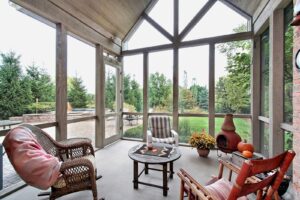A lot of our customers have difficulty deciding between a cedar vs pressure treated deck, and it’s not hard for us to understand why.
Both can be great for certain applications, and neither of them is ever really an overwhelmingly bad choice.
Ultimately, you’re not trying to choose between a good option and a bad one; you’re trying to choose the best of two good options.
As you’re reading this article, you’ll probably figure out that we have our own preference for most deck applications, but it’s up to you at the end of the day.
*Note: In most but not all cases, “pressure treated wood” is pine.
Chemical Free?
This is one of the first questions that comes up when people are trying compare cedar vs pressure treated decks, and it’s an important question.
Aside from all the obvious concerns about environmental impact and sustainable sourcing, certain historically common chemicals have been known to be less safe to plants and people and might require additional safety measures to prevent harmful chemical exposure.
Cedar, on the other hand, is a more natural and less chemically risky alternative to the pressure treated wood that is more commonly used in decks.
Pressure treated wood is a bit cheaper than cedar but, as with so many things in life, you pay more for quality and you tend to get what you pay for.
If you can afford cedar, it’s going to be the better option when it comes to reducing yours and your family’s overall chemical exposure and “toxic load.”
Weight?
Because the process of treating wood involves adding chemicals to the wood and thus increasing its weight, pressure treated wood tends to weight slightly more than cedar.
By contrast, cedar is specifically known for its low density and weight.
This is, in fact, one of the reasons why customers and contractors alike love working with cedar.
It’s generally easy to transport, lift, move, and work with.
That being said, the weight difference between cedar vs pressure treated decks isn’t tremendous and won’t make a dramatic difference in whether or not your deck will be structurally sound.
But you can certainly ask your contractor about the logistical details while your are asking them the other questions that you should be asking them before you hire them.
Insect-Resistant?
This is another important question that people should really ask more.
Insects can often be bad news for wood unless something is done to keep them at bay.
Fortunately though, this may not be the case for either cedar or pressure treated pine because the natural oils (in the case of cedar) and chemicals (in the case of pressure treated pine) function as a kind of repellent against many types of insects.
So, there isn’t a huge difference between cedar vs pressure treated deck in this regard.
But for the simple fact that it doesn’t necessarily need to involve synthetic chemicals, we’re going to give it to cedar.
Let Us Help with Your Outdoor Living Project
A Deck Above is the area’s premier builder of decks and a wide variety of structures to maximize your enjoyment of outdoor living.
Color & Appearance?
Most people prefer cedar because it looks more natural, and it quite literally is.
But it ultimately comes down to personal preference.
Some people prefer pressure-treated pine because it tends to have a more consistent and uniform appearance.
Cedar is all-natural wood with no two planks being identical, so there will naturally be more variation in the way different parts of your deck look.
In other words, it looks a bit less uniform, but a lot more natural – sort of like all the rest of the stuff in your yard.
Costs?
We won’t lie here, cedar is generally going to be more expensive.
However, when it comes to cedar vs pressure treated decks, you will tend to get what you pay for.
A deck is an investment that you should ideally only have to pay for once every 20 years or so.
And not pinching pennies or cutting corners helps to ensure that you don’t have to spend more money at unpredictable intervals to either repair or replace damaged sections of your deck.
Conclusion
Overal and in general, in the comparison of cedar vs pressure treated deck, cedar is probably the better of the two for most applications and it usually going to come out on top.
It will probably cost a bit more than pressure treated pine, but it won’t contain the harmful synthetic chemicals that pressure treated pine might and it is likely to offer various other benefits in addition to that due to the fact that it simply doesn’t rely on potentially harmful synthetic chemicals for it structural integrity, color, inset resistance, or any of its other characteristics or properties.
Pressure treated pine may have its uses but, unless you just can’t afford cedar, it might be best in the long run if your deck is not one of those uses.
However, if you do end up choosing pressure treated pine, taking a few additional safety precautions to protect yourself, your family, and the soil on your property from unnecessary chemical exposure can mitigate a lot of the additional risks of using pressure treated wood.
When it comes down to it, the comparison of cedar vs pressure treated deck is really a comparison between an entirely natural building material and one that was originally natural but has been treated in such a way that it has absorbed a significant quantity of artificial preservatives and other synthetic chemicals.


